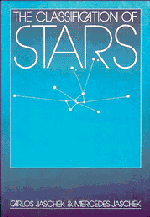15 - Degenerates
Published online by Cambridge University Press: 04 April 2011
Summary
White dwarfs
Objects lying five or more magnitudes below the main sequence are called ‘white dwarfs’.
The name was attributed to them because the spectrum of the first star analysed, 40 Eri B (Adams 1914), was of type A and the star white, whereas dwarfs were thought to be all of type M and therefore red. So the term calls attention to the inconsistency between the color or spectral type and the luminosity (or absolute magnitude) of the star. Since, however, the stars are neither white nor dwarfs, it would be more logical to call them ‘degenerates’ (D) because of the equation of state of the matter composing them. We shall use the latter term.
Detection methods. Degenerates, being intrinsically faint, are difficult to single out among the large number of faint stars. (Let us remember that there are about 2 × 107 stars brighter than B = 15.) Detection methods are thus of fundamental importance. Essentially three methods have been used to isolate candidates. The first is to search for nearby stars through their proper motion, and retain those which are blue. The second is to search spectroscopically for blue stars where no intrinsically bright stars are expected. The third is to search for faint companions to brighter nearby stars.
The first method was proposed and exploited by Luyten, from 1931 on. From an examination of about 108 star images on plates taken at different epochs, Luyten selected those stars whose proper motion is larger than a given amount (for instance 17″).
- Type
- Chapter
- Information
- The Classification of Stars , pp. 377 - 394Publisher: Cambridge University PressPrint publication year: 1987

